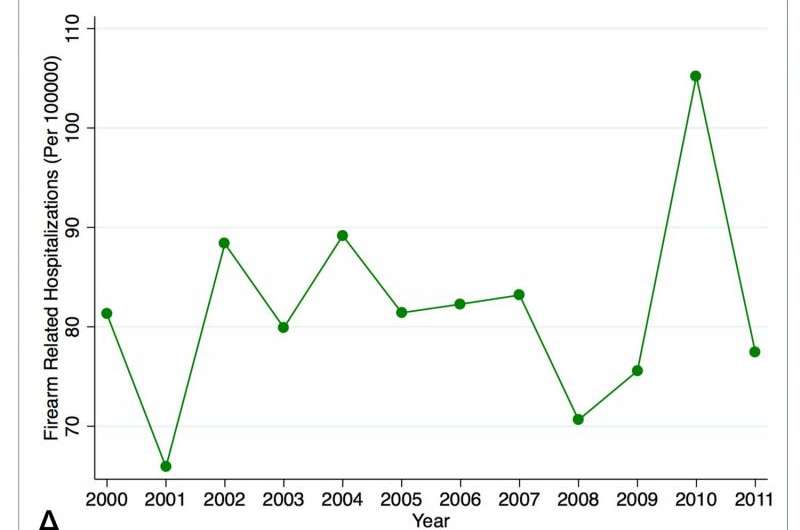Correlation between firearm-related hospitalizations and US stock market performance

Over 2001-2011, the national incidence of firearm-related hospitalizations has closely tracked the national stock market performance, suggesting that economic perturbations and resultant insecurities might underlie the perpetuation of firearm-related injuries, according to a new study published in The American Journal of Medicine. Although the fatality rates have remained stable over the last two decades, the average length of stay and hospitalization costs have increased, imposing additional burden on existing healthcare resources.
Firearms are the second leading cause of injury-related deaths after motor vehicle accidents in the U.S. with approximately 88 people dying every day, including suicides, homicides, unintentional injuries, or accidents. "Although there is a large amount of literature detailing the vital statistics relating to firearm-injuries, there is a conspicuous paucity of literature exploring burden on healthcare resources imposed by firearm injuries," explained author Shikhar Agarwal, MD, MPH, Department of Cardiovascular Medicine, Cleveland Clinic. "One could surmise that there would be a relationship between the national economic situation and national firearm-related hospitalization rates."
Dr. Agarwal analyzed data from the Nationwide Inpatient Sample (NIS) database from 2001-2011, which indicated that 70,974 hospitalizations were the result of firearm-related injuries. The number of hospitalizations fluctuated during this timeframe with a modest increase during 2002 and 2004, a slow decline until 2008, a sharp increase in 2009 and 2010, followed by a sharp decline in 2011.
The overall fatality rate for hospitalization following firearm-related injury has been stable at about 8%, with suicide responsible for more than 30% of those deaths. Analysis of the data also showed that there has been an increase in the prevalence of mental-health disorders among people admitted with firearm-related injuries.
Using the Dow Jones Industrial Average as an indicator of the overall economic health of the country, Dr. Agarwal determined that "the national incidence of firearm-related hospitalizations in the US has closely tracked the national stock market performance, suggesting that economic perturbations may be a 'root cause' or at least an important predictor of firearm injuries."
Separating the data into two time intervals, 2001-2006 and 2007-2011, Dr. Agarwal found that there was a small but significant drop in the number of patients discharged to home during the later time interval. In addition, the average length of stay following firearm-related injury increased from 6.6 days in 2001-2006 to 7.4 days in 2007-2011, including a significant increase in the proportion of patients who were in hospital for more than 10 days (18.1% in 2001-2006 to 20.8% in 2007-2011.) This was also associated with an average hospitalization cost of $25,155 in 2007-2011 vs. $20,686 in 2001-2006.















